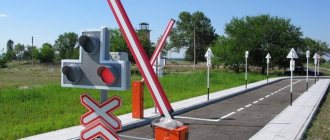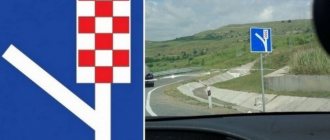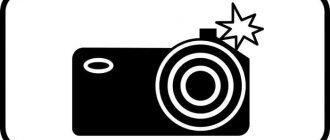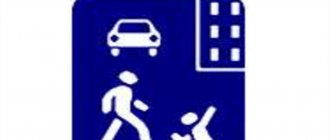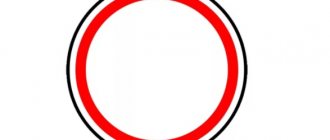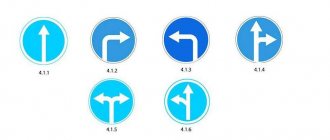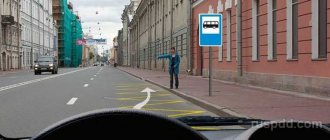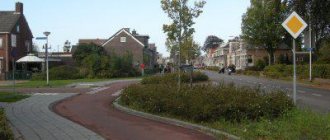Varieties
In practice, there are two types of railway crossings.
These include:
- One that is regulated. According to the rules, this type is equipped with a traffic light and a barrier. A person on duty is installed to monitor their work. Regarding traffic, such crossings are safer for people if we consider them from the point of view of the presence of warning signals. However, accidents often occur at such crossings.
- The move is not regulated. The railroad crossing road sign like a picture can be found in villages. They are considered less dangerous, since the road passes through the rails less often here. In addition, freight trains that do not have high speed often travel along such a road.
In places where there are tracks with fast locomotives moving along them carrying passengers, the first type of crossing is installed. This is due to the fact that during emergency braking, the composition can cause irreparable consequences for the life or health of the person in the car.
If a train collides with a passenger car at high speed, casualties in the passenger car cannot be avoided. This could be a woman or a man. However, this does not mean that an unregulated crossing can be ignored by the motorist. It is understood that a person should move through such a place with special vigilance. This mainly applies to night time.
Signs
A railway crossing sign is installed near such a crossing, and the icon indicates the designation of its type.
There are several options:
- there may be a single track in front;
- multi-track road.
If the tracks are single-track, this means that only one train can move on such rails, which goes in one direction. Such a road carries no less danger. When the train has passed, you can continue moving after you hear the permission signal.
A crossing road sign may indicate that there is a multi-track road ahead. This implies that composition can be expected from either side. The sign will warn of approaching trains. If the train has passed, but the prohibitory signal is still on, you should not move. Perhaps the train is moving from a different direction.
It should also be noted that a crossing sign is installed 200 meters or less before the crossing if we are not talking about a populated area. You need to pay attention to how many stripes are shown on the sign. Often such images are found in the coloring books of a child whose parents teach him safety from childhood.
When three stripes are drawn, this indicates that there are about 150 meters left to the tracks. Accordingly, 100 meters - two lanes and 50 - one. In photographs and in real life, the sign will look like a rectangular background with a red oblique line. Install it on the right side of the road.
For his safety, the driver must take into account the established rules at each interval of the roadway. According to GOST, it is stipulated that signs are also installed indicating that it is forbidden to move without stopping. This suggests that the driver must take the following action: stop the vehicle and make sure there are no trains.
When a train moves along the rails, you need to give way to it. In villages and other areas, most often, the stop does not last more than two minutes. This is due to the fact that during such a period of time the driver can fully assess the current situation and understand whether it is worth driving or not.
What are the penalties for violating traffic rules?
As with any type of traffic violation, improper crossing or illegal actions on railroad tracks will result in penalties. In this situation, the punishment is established in accordance with Article 12.10 of the Code of Administrative Offenses of the Russian Federation
The amount of the penalty seems small, namely 1000 rubles. The fine is imposed:
- If the driver made or began to move along railway tracks in a place not equipped for this;
- If the driver continued driving at the moment when the barrier was lowered or began to lower. You also need to remember that you can start moving only after the barrier has completely risen again;
- If a prohibiting signal is on at a special traffic light;
- The vehicle stopped or parked directly on the road. An exception is if the stop was forced. As already mentioned, the presence of a traffic jam ahead is not a good reason.
Fines are not the only punishment. The driver's actions may be perceived as dangerous or creating an increased risk. Therefore, as an alternative, a citizen may be punished by deprivation of the right to use a vehicle for a period of 3 months to six months.
Also, the punishment is tougher if the driver has previously been charged under this article. In this case, the citizen will be deprived of his rights for a period of 1 year.
Without barrier
The acquaintance must take place and there is a railway crossing sign with a barrier. This sign indicates that there is a crossing ahead, which was not equipped with a barrier. Similar paths are installed in villages with a small population.
The installation is implemented twice:
- Initially at a distance of 300 to 150 meters. The distance to the crossing is indicated.
- Less than 50 meters from the tracks.
This setting is needed to warn a person who missed the first sign.
It is understood that special care and attention will be required in this area. The agreed condition is that in urban areas the designations in question are installed extremely rarely. In the city, the sign is placed once - 50 or 100 meters before the tracks. Outside the populated area - a double installation of the sign is required, which may be accompanied by additional symbols.
For example, they install a traffic light, sound signals, etc. It is recommended to pay attention to multi-track roads that are not regulated. According to the photo, you need to make sure that there are no trains on all sides in this area, and then start moving.
With barrier
A railway crossing sign without or with a barrier is enshrined in the rules established according to road traffic. This sign can often be seen in photographs. The driver must automatically understand that he is talking about the location of the road ahead with a barrier. It is usually supplemented by signals or traffic lights.
Worth considering:
- adjustment is carried out automatically;
- the person on duty can also control it.
In a populated area, installation is organized once. The specified permit is placed outside the city twice.
Distance
The size depends on the zone in which the sign is installed.
Including:
- If it refers to a populated area, then it is placed once. The distance must be at least 50 meters to the tracks.
- If outside the village, warnings are posted twice. The first time was 200 meters before the danger and the second time was 50 meters away.
You can download the rules for installing signs that reflect the dependencies on the type of crossing. If we talk about adjustable crossings, then they install it 2 or 3 meters before the barrier. If there is an unregulated crossing ahead, then the installation is carried out at a similar distance from the last sign.
Russian traffic signs 2021
1.4.1 – 1.4.6 “Approaching a railway crossing.”
Signs 1.4.1 – 1.4.6 warn of approaching a railway crossing outside populated areas. These signs have oblique red stripes and a countdown: three, two, one - the fewer stripes, the closer the crossing.
Signs 1.4.1 – 1.4.6 are installed
150-300 m before the railway crossing, a sign with three stripes under the sign 1.1 or 1.2 is installed:
or
The second sign with two stripes is installed independently approximately 100-200 m before the railway crossing.
or
The third sign with one lane is installed under the duplicate sign 1.1 or 1.2 at least 50 m before the railway crossing.
or
Such signs are not installed in populated areas.
immediately before a railway crossing without a barrier :
1.3.1 “Single-track railway”. Means that the roadway is crossed by only one railway track.
1.3.2 “Multi-track railway”. Means that the roadway is crossed by two or more railway tracks.
2.5 “Driving without stopping is prohibited.” It is prohibited to drive without stopping in front of the stop line, and if there is none, in front of the edge of the roadway being crossed. Sign 2.5 can be installed in conjunction with 1.3.1 and 1.3.2.
Rules
You should also become familiar with the rules regarding moving.
It is necessary to understand the basic rules established regarding the signs in question:
- It is prohibited to stop at crossings;
- when there is a traffic jam behind the tracks, you cannot cross them;
- It is prohibited to organize parking closer than 50 meters to the tracks.
Motorists must understand that they cannot stop at crossings even for a short period of time, not to mention parking. Attention should be paid to the rules that indicate forced stops at crossings. This assumes that the stop was implemented through no fault of the driver. For example, a car has a malfunction. The car could also make an emergency stop, causing the car to stop on the rails.
In such a situation, rules apply that indicate the need to remove all passengers from the car and take them away from the rails for their safety. Next, one person is sent in both directions in order to be able to inform the train driver that the tracks are not clear. To do this, you need to pick up a flashlight or a rag and wave them.
You are also required to stay near the car at all times and sound alarms. If the train appears in the visibility zone, you need to run towards it and give signals. It should be taken into account that you should not move along the rails, but next to them. The duty officer should be made aware of what is happening. If these rules are not followed, the perpetrator faces punishment from the traffic police. There may also be an accident where people get hurt.
STOP sign
Some people believe in dream books and zodiac signs, however, this cannot be done in the situation under consideration.
If the driver sees a stop sign, he needs to turn off the engine and make sure that it is safe to continue driving. This sign is placed near the tracks. However, it always has this designation. Need to remember:
- If the crossing is not regulated, you need to stop the car and make sure it is safe to move. All directions should be examined.
- If the stop is not made, it is a violation of the rules.
In a situation where there is a controlled crossing ahead, the stop sign does not have a decisive meaning. This is due to the fact that attention is paid to the traffic light. When the red light is on, you must stop the car. When there is no such signal, there is no need to stop.
Rules for crossing a railway crossing
Vehicles are allowed to travel on railway tracks only in specially designated areas. The speed of movement in this area must correspond to the pace of the traffic flow. In conditions where there is a temporary ban on crossing the railway, the driver is obliged to stop traffic. Near a crossing, it is necessary to prevent spontaneous movement of the vehicle.
Adjustable
A crossing is considered regulated if it is equipped with traffic lights, semaphores, barriers, sound signals and signs. If there is systematically heavy traffic on it and there is a densely populated area nearby, there may be an authorized duty officer regulating the process of crossing the railway track. In its absence, driving on a white traffic light with the barrier open is permitted.
Constantly lit or alternately flashing red signals and the closed position of the device blocking the way prohibit passage. When the traffic light is not working, the main regulatory object becomes the barrier.
Did you know? The first driver to be fined for breaking the speed limit was London motorist Walter Arnold. In 1896, he accelerated the car to 13 km/h, which was 10 km/h more than the maximum limit.
Unregulated
Unregulated railway crossings are characterized by the absence of warning signals, traffic blocking devices and are not controlled by the duty officer. The crossing of this section is organized by installing road signs and traffic regulations. If there is a non-working traffic light and an open barrier at the same time, the crossing is also considered unregulated. In this case, the driver will travel in compliance with the general traffic rules.
When the traffic light is on
Traffic rules indicate:
- when the barrier is lowered or has already lowered, you cannot enter the crossing;
- if the red signal is on, you cannot drive onto the rails in any case, no attention is paid to the barrier here;
- when the duty officer gives a special signal, you cannot enter the rails;
- Different signals are not taken into account if a train is approaching a crossing.
In addition, you need to remember about the prohibitions on overtaking a vehicle that is moving in front, while entering the lane for oncoming traffic. Even if the train is not in sight, you cannot open barriers in the form of barriers yourself, and you should not use the crossing to transport special equipment. To move on the device’s rails at a speed of less than 8 kilometers per hour, you must obtain the consent of the person on duty.
Penalties
Fines and penalties vary depending on the severity of the violation and its possible consequences. According to traffic police statistics, most often a decree is issued for driving through a prohibitory signal. The punishment in this case may be deprivation of rights for up to 1 year. If the rules for overtaking in the railway crossing zone are violated, the culprit faces a fine of 1.5 thousand rubles.
Important! Driving around objects that impede traffic and then driving into the oncoming lane does not constitute a traffic violation.
If you stop on a railway track, you will have to pay a fine of 500 rubles.
